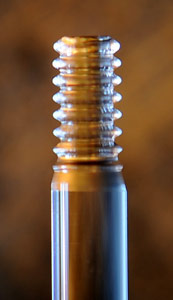SCIENCE
Future 'Comb on a Chip': NIST's Compact Frequency Comb Could Go Places
 .
.Now, researchers at the National Institute of Standards and Technology (NIST) have developed a compact laser frequency comb, a step toward user-friendly and ultimately chip-based combs that could enable new applications in astronomical searches for Earth-like planets, high-capacity telecommunications, and—if other components are miniaturized as well—portable versions of the most advanced atomic clocks. Large frequency combs are best known as the "gears" in today's room-sized versions of these clocks.
NIST's prototype micro-comb consists of a low-power semiconductor laser about the size of a shoebox and a high-quality optical cavity just 2 millimeters wide. A miniature laser like those in DVD players might be substituted in the future to squeeze the whole comb apparatus onto a microchip.
Compact frequency combs have been developed recently by a number of other research groups, but NIST's is the first to use a cavity made of fused silica, or quartz, the most common optical material. This means it could be integrated easily with other optical and photonic components, lead author Scott Papp says.
A full-size frequency comb uses a high-power, ultrafast laser. By contrast, the new compact version relies on a low-power laser and the cavity's unusual properties. The cavity is designed to limit light dispersion and confine the light in a small space to enhance intensity and optical interactions. The infrared laser light travels in a loop inside the cavity, generating a train of very short pulses and a spectrum of additional shades of infrared light. The small cavity, with no moving parts, offers insight into basic processes of frequency combs, which are difficult to observe in large versions.
Among its desirable features, NIST's compact comb has wide spacing between the teeth—10 to 100 times wider than that found in typical larger combs. This spacing allows scientists to more easily measure and manipulate the teeth. Of particular interest to project leader Scott Diddams, the widely spaced teeth can be individually read by astronomical instruments. Portable frequency combs can thus be used as ultrastable frequency references in the search for Earth-like planets orbiting distant stars. Portable frequency combs can also have many other important applications. For example, because a frequency comb can simultaneously generate hundreds of telecommunication channels from a single low-power source, a micro-comb might eventually replace individual lasers now used for each channel in fiber-optic telecommunications.
"We hope this is just the beginning and look forward to bigger and better developments," Diddams says. "In the short term we want to learn if this new type of comb can one day replace ultrafast laser-based combs used with NIST's best atomic clocks. And if not, its small size will likely lead to other opportunities."
The research was supported in part by the Defense Advanced Research Projects Agency.
